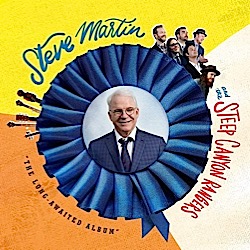Exclusive: Steve Martin Talks About His New Album and How He Tells Stories in Song
The comedy icon is set to release The Long Awaited Album on Friday.
Photo: Anna Webber
Steve Martin has never been one for convention. As a comedian coming up in the 1960s, he toyed with his audiences, subverting jokes by injecting them with unbearable tension and strange non-sequiturs rather than the easy release of a punchline. The brand of anti-comedy that Martin helped pioneer rarely comes with the surface delights of bunny ears or juggling tricks or an arrow through the head, but he was able to package the absurd with the philosophical to fill arenas in the late 1970s before abruptly walking away from stand-up comedy in 1981. As he wrote in his 2007 memoir, Born Standing Up, “I was not naturally talented—I didn’t sing, dance, or act—though working around that minor detail made me inventive.”
Three careers later, having found similar success in film acting and fiction writing, Martin now brings that style of accessible yet challenging performance to his ever-expanding life in music, poking at the boundaries of tradition to give people what they didn’t realize they wanted.
When Martin and the North Carolina-based band Steep Canyon Rangers convened to record their new album, The Long-Awaited Album, it wasn’t exactly a surprise that the project would be rooted in bluegrass, with plenty of banjo playing. Martin and the Rangers earned a Grammy nomination in 2011 for their first collaboration, Rare Bird Alert, and Martin showcased his evolving picking style on two subsequent albums with Edie Brickell, as well as the 2016 Tony-nominated Broadway musical Bright Star, based on the duo’s music.
But one listen to The Long-Awaited Album opener “Sante Fe,” with its flurry of mariachi trumpets, makes it evident that he isn’t going to stand on ceremony or rest on traditions. Putting horns on a bluegrass song has historically been a no-no, but with the help of producer Peter Asher—best known for recording albums by Linda Ronstadt, James Taylor and Neil Diamond—Martin was moved once again to bend the rules.
Asher had worked with mariachi players while producing records for Ronstadt. “Luckily, I still had all my mariachi phone numbers so I was able to make the call and get two great L.A. mariachi trumpet players, who totally loved the song and got into the spirit of it and played along,” he says. “We liked the freedom to experiment a bit.”
Martin began writing “Santa Fe” about five years ago, and when he revisited it he realized it would sound better with the trumpets. He had spent some time living in the New Mexico capital, where he heard plenty of mariachi music, so the sound was dear to him. “What could be more appropriate if you’re writing a song about Santa Fe than to have those joyful horns be on there?” he says.
“As the years have gone on, I’ve been more of a writer and have paid a lot of attention to storytelling, and am always looking for experience in it. I do feel comfortable telling stories in a three-minute song.”
Martin points out that in recent years, “bluegrass’s role has become much more open to experiments,” but also noted that he and the Rangers included a version of “Santa Fe” without the trumpets for the “hardcore bluegrass stations,” just in case.
But he is adamant that there is ample room for innovation in bluegrass—which traces its history to the roots of Appalachian string music and early American jazz—as well as with the banjo itself.
“It’s become an extremely sophisticated instrument thanks to players like Bela Fleck, Noam Pikelny and Tony Trischka,” he says. “Bela Fleck’s writing concertos for the banjo to be played with an orchestra. So the banjo is in a different place. It’s getting the word out that’s a little difficult, because it’s complex. The banjo is very complex, especially when played three-fingered. Clawhammer is generally more melodic and accessible for a lot of people.”
-

-

-

-

-

-

-

-

-

-

-

-

-

-

-

-

-

-

-

-

-

-

-

-

-

-

-

-

-

-

-

-

-

-

-

-

-

-

-

-










































